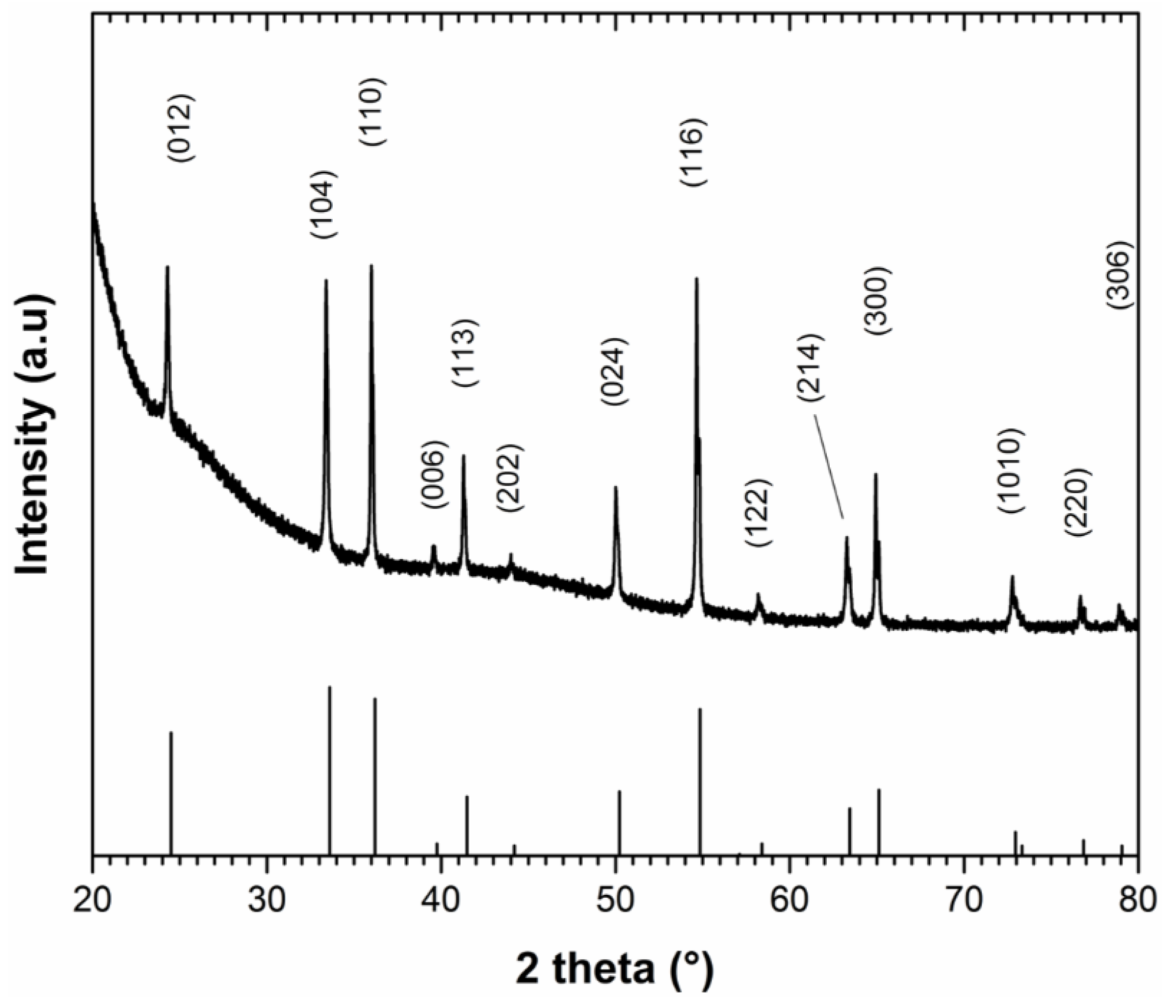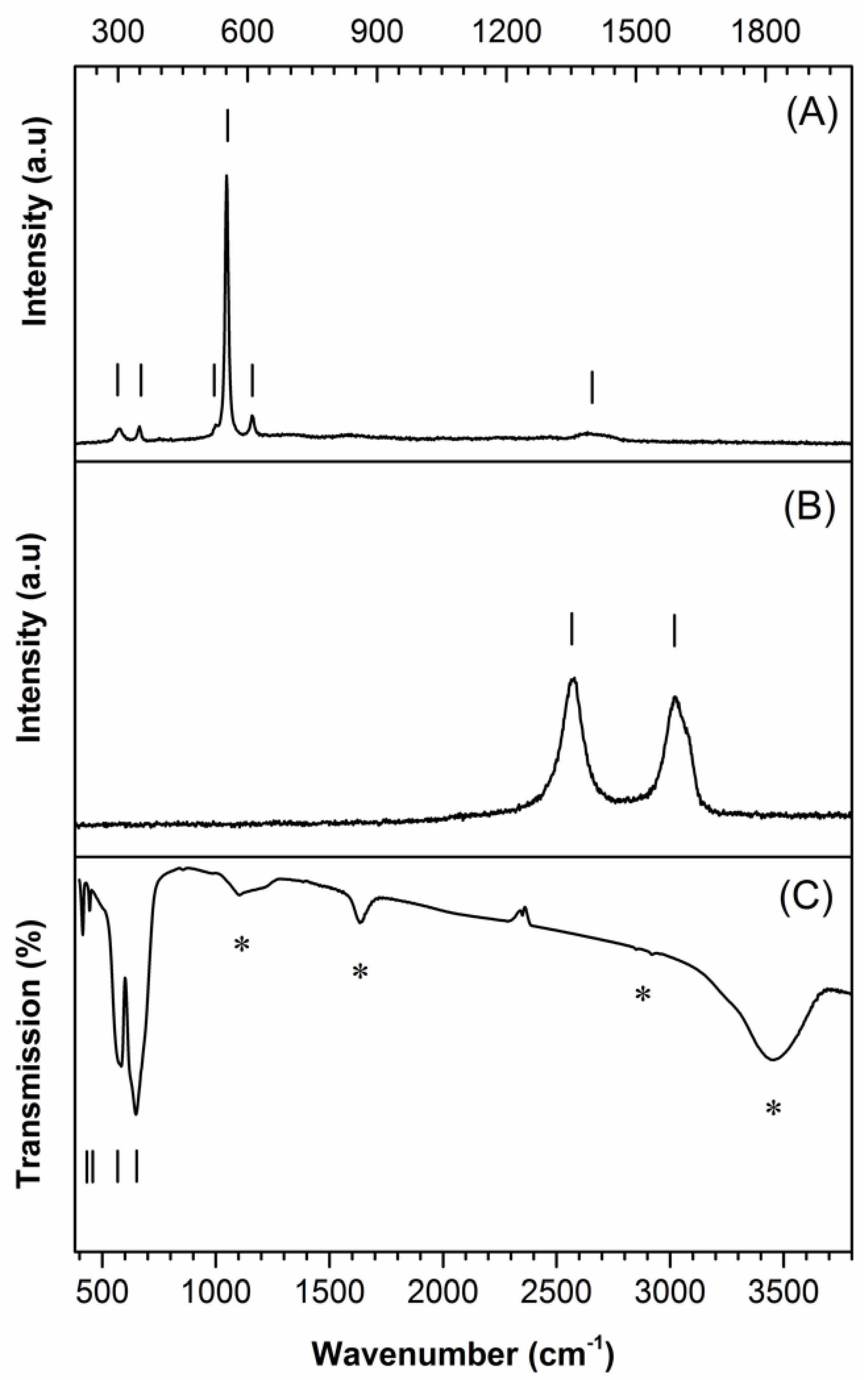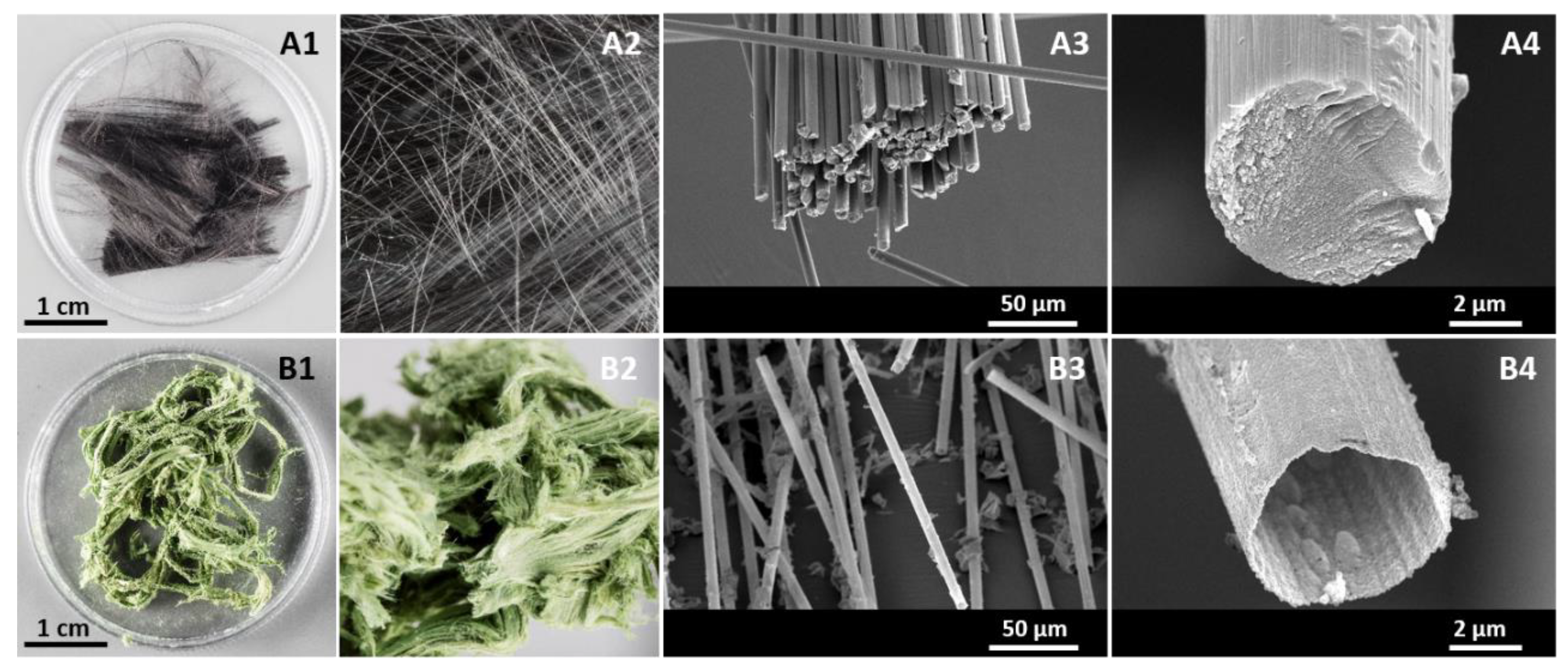Centimetric-Sized Chromium (III) Oxide Object Synthesized by Means of the Carbon Template Replication
Abstract
1. Introduction
2. Materials and Methods
2.1. Synthesis of the Cr2O3 Chromium (III) Oxide Tubes
2.2. Characterization Techniques
3. Results and Discussion
4. Conclusions
Supplementary Materials
Funding
Acknowledgments
Conflicts of Interest
References
- Patzke, G.R.; Zhou, Y.; Kontic, R.; Conrad, F. Oxide nanomaterials: Synthetic developments, mechanistic studies, and technological innovations. Angew. Chem. Int. Ed. Engl. 2011, 50, 826–859. [Google Scholar] [CrossRef]
- Garcia, Y.; Su, B.L. Introduction to the themed issue on Advanced Complex Inorganic Nanomaterials. New J. Chem. 2014, 38, 1825–1826. [Google Scholar] [CrossRef]
- Berdhal, P. Pigments to reflect the infrared radiation from fire. J. Heat Transf. 1995, 117, 355–358. [Google Scholar] [CrossRef]
- Kitsunai, H.; Hokkirigawa, K.; Tsumaki, N.; Kato, K. Transitions of microscopic wear mechanism for Cr2O3 ceramic coatings during repeated sliding observed in a scanning electron microscope tribosystem. Wear 1991, 151, 279–289. [Google Scholar] [CrossRef]
- Cherian, M.; Rao, M.S.; Yang, W.T.; Jehng, J.M.; Hirt, A.M.; Deo, G. Oxidative dehydrogenation of propane over Cr2O3/Al2O3 and Cr2O3 catalysts: Effects of loading, precursor and surface area. Appl. Catal. A 2002, 233, 21–33. [Google Scholar] [CrossRef]
- An, G.; Zhang, Y.; Liu, Z.M.; Miao, Z.J.; Han, B.X.; Miao, S.D.; Li, J.P. Preparation of porous chromium oxide nanotubes using carbon nanotubes as templates and their application as an ethanol sensor. Nanotechnology 2008, 19, 035504–035511. [Google Scholar] [CrossRef] [PubMed]
- Wang, Y.; Yuan, X.; Liu, X.; Ren, J.; Tong, W.; Wang, Y.; Lu, G. Mesoporous single-crystal Cr2O3: Synthesis, characterization, and its activity in toluene removal. Solid State Sci. 2008, 10, 1117–1123. [Google Scholar] [CrossRef]
- Suryawanshi, D.N.; Patil, D.R.; Patil, L.A. Fe2O3-activated Cr2O3 thick films as temperature dependent gas sensors. Sens. Actuators B 2008, 134, 579–584. [Google Scholar] [CrossRef]
- Fischer, S.H.; Grubelich, M.C. Theoretical energy release of thermites, intermetallics, and combustible metals. In Proceedings of the 24th International Pyrotechnics Seminar, Monterey, CA, USA, 27–31 July 1998; pp. 231–286. [Google Scholar]
- Gibot, P.; Comet, M.; Eichhorn, A.; Muller, O.; Ciszek, F.; Boehrer, Y.; Schnell, F.; Spitzer, D. Highly insensitive/reactive thermite prepared from Cr2O3 nanoparticles. Propellants, Explos. Pyrotech. 2011, 36, 80–87. [Google Scholar] [CrossRef]
- Pei, Z.; Xua, H.; Zhang, Y. Preparation of Cr2O3 nanoparticles via C2H5OH hydrothermal reduction. J. Alloys Compd. 2009, 468, 5–8. [Google Scholar] [CrossRef]
- Kim, D.W.; Shin, S.I.; Lee, J.D.; Oh, S.G. Preparation of chromia nanoparticles by precipitation–gelation reaction. Mater. Lett. 2004, 58, 1894–1898. [Google Scholar] [CrossRef]
- Gibot, P.; Schnell, F.; Spitzer, D. Ca3(PO4)2 biomaterial: A nontoxic template to prepare highly porous Cr2O3. Mater. Lett. 2015, 161, 172–174. [Google Scholar] [CrossRef]
- Dickinson, C.; Zhou, W.; Hodgkins, R.P.; Shi, Y.; Zhao, D.; He, H. Formation Mechanism of Porous Single-Crystal Cr2O3 and Co3O4 Templated by Mesoporous Silica. Chem. Mater. 2006, 18, 3088–3095. [Google Scholar] [CrossRef]
- Tüysüz, H.; Weidenthaler, C.; Grew, T.; Lorena Salabaş, E.; Benitez Romero, M.J.; Schüth, F. A crystal structure analysis and magnetic investigation on highly ordered mesoporous Cr2O3. Inorg. Chem. 2012, 51, 11745–11752. [Google Scholar] [CrossRef] [PubMed]
- Chen, H.; Wang, N.; Di, J.; Zhao, Y.; Song, Y.; Jiang, L. Nanowire-in-microtube structured core/shell fibers via multifluidic coaxial electrospinning. Langmuir 2010, 26, 11291–11296. [Google Scholar] [CrossRef]
- Lang, L.; Xu, Z. Controllable synthesis of porous Fe2O3 microtube and tube-in-tube by non-coaxial electrospinning. Chem. Lett. 2013, 42, 750–752. [Google Scholar] [CrossRef]
- Cheng, J.; Guo, R.; Wang, Q.M. Zinc oxide single-crystal microtubes. Appl. Phys. Lett. 2004, 85, 5540–5542. [Google Scholar] [CrossRef]
- Jiang, Q.; Liu, Y.; Kan, H.; Yuan, B.; Zhao, H. Microwave-assisted synthesis of hexagonal structure ZnO micro-tubes. Mater. Lett. 2012, 81, 198–201. [Google Scholar] [CrossRef]
- Bao, N.; Wei, Z.; Ma, Z.; Liu, F.; Yin, G. Si-doped mesoporous TiO2 continuous fibers: Preparation by centrifugal spinning and photocatalytic properties. J. Hazard. Mater. 2010, 174, 129–136. [Google Scholar] [CrossRef]
- Kroll, S.; Brandes, C.; Wehling, J.; Treccani, L.; Grathwohl, G.; Rezwan, K. Highly efficient enzyme-functionalized porous zirconia microtubes for bacteria filtration. Environ. Sci. Technol. 2012, 46, 8739–8747. [Google Scholar] [CrossRef]
- Jarvekulg, M.; Valbe, R.; Jogi, J.; Salundi, A.; Kangur, T.; Reedo, V.; Kalda, J.; Maeorg, U.; Lohmus, A.; Romanov, A.E. A sol–gel approach to self-formation of microtubular structures from metal alkoxide gel films. Phys. Status Solidi A. 2012, 209, 2481–2486. [Google Scholar] [CrossRef]
- Li, M.K.; Wang, D.Z.; Ding, S.; Ding, Y.W.; Liu, J.; Liu, Z.B. Synthesis and properties of aligned ZnO microtube arrays. Appl. Surf. Sci. 2007, 253, 4161–4165. [Google Scholar] [CrossRef]
- Huang, H.; Liu, X.; Huang, J. Tubular structured hierarchical mesoporous titania material derived from natural cellulosic substances and application as photocatalyst for degradation of methylene blue. Mater. Res. Bull. 2011, 46, 1814–1818. [Google Scholar] [CrossRef]
- Xie, L.J.; Chu, W.; Huang, Y.Y.; Tong, D.G. Preparation and characterization of biomorphic nickel oxide microtubes templated from cotton. Mater. Lett. 2011, 65, 153–156. [Google Scholar] [CrossRef]
- Zhou, X.; Huang, B.; Zou, Y.; Xie, J.; Yang, J. Cotton-templated fabrication of hierarchical SnO2 mesoporous microtubes as the anode material of lithium ion battery. Mater. Lett. 2014, 120, 279–282. [Google Scholar] [CrossRef]
- Liu, S.; He, J. Facile fabrication of porous titania microtube arrays by replication of human hair. J. Am. Ceram. Soc. 2005, 88, 3513–3514. [Google Scholar] [CrossRef]
- Yang, L.; Li, X.; Wang, Z.; Shen, Y.; Liu, M. Natural fiber templated TiO2 microtubes via a double soaking sol-gel route and their photocatalytic performance. Appl. Surf. Sci. 2017, 420, 346–354. [Google Scholar] [CrossRef]
- Hwang, K.J.; Hwang, C.H.; Lee, I.H.; Kim, T.; Jin, S.; Park, J.Y. Synthesis and characterization of hollow metal oxide micro-tubes using a biomaterial template. Biomass Bioenergy 2014, 68, 62–66. [Google Scholar] [CrossRef]
- Liu, D.; Yates, M.Z. Fabrication of size-tunable TiO2 tubes using rod-shaped calcite template. Langmuir 2007, 23, 10333–10341. [Google Scholar] [CrossRef]
- Motojima, S.; Suzuki, T.; Noda, Y.; Hiraga, A.; Iwanaga, H.; Hashishin, T.; Hishikawa, Y.; Yang, S.; Chen, X. Preparation of TiO2 microcoils from carbon microcoil templates using a sol–gel process. Chem. Phys. Lett. 2003, 378, 111–116. [Google Scholar] [CrossRef]
- Liu, X.; Du, H.; Sun, X.W.; Liu, B.; Zhao, D.; Sun, H. Visible-light photoresponse in a hollow microtube–nanowire structure made of carbon-doped ZnO. CrystEngComm. 2012, 14, 2886–2890. [Google Scholar] [CrossRef]
- Valtchev, V.; Schoeman, B.J.; Hedlund, J.; Mintova, S.; Sterte, J. Preparation and characterization of hollow fibers of silicalite-l. Zeolites 1996, 17408, 408–415. [Google Scholar] [CrossRef]
- Indra, A.; Paik, U.; Song, T. Boosting Electrochemical Water Oxidation with Metal Hydroxide Carbonate Templated Prussian blue Analogues. Angew. Chem. Int. Ed. 2018, 57, 1241–1245. [Google Scholar] [CrossRef] [PubMed]
- Liu, W.; Zhang, L.; Cao, L.X.; Su, G.; Wang, Y.G. Glass fibers templated preparation of TiO2 microtubes assembled from nano/micro hierarchical TiO2 crystals. J. Alloys Compd. 2011, 509, 3419–3424. [Google Scholar] [CrossRef]
- Vix-Guterl, C.; Alix, I.; Gibot, P.; Ehrburger, P. Formation of tubular silicon carbide from a carbon–silica material by using a reactive replica technique: Infra-red characterization. Appl. Surf. Sci. 2003, 210, 329–337. [Google Scholar] [CrossRef]
- Gibot, P.; Vix-Guterl, C. TiO2 and [TiO2/SiC] microtubes prepared from an original process. J. Eur. Ceram. Soc. 2007, 27, 2195–2201. [Google Scholar] [CrossRef]
- Wang, A.; Bok, S.; Thiruvengadathan, R.; Gangopadhyay, K.; McFarland, J.A.; Maschmann, M.R.; Gangopadhyay, S. Reactive nanoenergetic graphene aerogel synthesized by one-step chemical reduction. Combust. Flame. 2018, 196, 400–406. [Google Scholar] [CrossRef]
- Comet, M.; Martin, C.; Schnell, F.; Spitzer, D. Nanothermite foams: From nanopowder to object. Chem. Eng. J. 2017, 316, 807–812. [Google Scholar] [CrossRef]
- Yang, S.; Jian, G.; Zachariah, M.R. Electrospun nanofiber-based thermite textiles and their reactive properties. ACS Appl. Mater. Interfaces. 2012, 4, 6432–6435. [Google Scholar]
- Yang, Y.; Zhang, Z.C.; Wang, P.P.; Zhang, J.C.; Nosheen, F.; Zhuang, J.; Wang, X. Hierarchical MnO2/SnO2 heterostructures for a novel free-standing ternary thermite membrane. Inorg. Chem. 2013, 52, 9449–9455. [Google Scholar] [CrossRef]
- Dong, H.; Chen, Y.-C.; Feldmann, C. Polyol synthesis of nanoparticles: Status and options regarding metals, oxides, chalcogenides, and non-metal elements. Green Chem. 2015, 17, 4107–4132. [Google Scholar] [CrossRef]
- Shim, S.H.; Duffy, T.S.; Jeanloz, R.; Yoo, C.S.; Iota, V. Raman spectroscopy and x-ray diffraction of phase transitions in Cr2O3 to 61 GPa. Phys. Rev. B Solid State 2004, 69, 144107–144119. [Google Scholar] [CrossRef]
- Mougin, J.; Le Bihan, T.; Lucazeau, G. High-pressure study of Cr2O3 obtained by high-temperature oxidation by X-ray diffraction and Raman spectroscopy. J. Phys. Chem. Solids 2001, 62, 553–563. [Google Scholar] [CrossRef]
- Ferrari, A.C.; Robertson, J. Interpretation of Raman spectra of disordered and amorphous carbon. Phys. Rev. B Solid State 2000, 61, 14095–14107. [Google Scholar] [CrossRef]
- Musi, S.; Maljkovi, M.; Popovi, S.; Trojko, R. Formation of chromia from amorphous chromium hydroxide. Croat. Chem. Acta 1999, 72, 789–802. [Google Scholar]
- Serna, C.J.; Rendon, J.L.; Iglesias, J.E. Infrared surface modes in corundum-type microcrystalline oxides. Spectrochim. Acta 1982, 38, 797–802. [Google Scholar] [CrossRef]
- Available online: https://webbook.nist.gov/cgi/cbook.cgi?ID=C7732185&Type=IR-SPEC&Index=1#IR-SPEC (accessed on 3 March 2020).




© 2020 by the author. Licensee MDPI, Basel, Switzerland. This article is an open access article distributed under the terms and conditions of the Creative Commons Attribution (CC BY) license (http://creativecommons.org/licenses/by/4.0/).
Share and Cite
GIBOT, P. Centimetric-Sized Chromium (III) Oxide Object Synthesized by Means of the Carbon Template Replication. Ceramics 2020, 3, 92-100. https://doi.org/10.3390/ceramics3010010
GIBOT P. Centimetric-Sized Chromium (III) Oxide Object Synthesized by Means of the Carbon Template Replication. Ceramics. 2020; 3(1):92-100. https://doi.org/10.3390/ceramics3010010
Chicago/Turabian StyleGIBOT, Pierre. 2020. "Centimetric-Sized Chromium (III) Oxide Object Synthesized by Means of the Carbon Template Replication" Ceramics 3, no. 1: 92-100. https://doi.org/10.3390/ceramics3010010
APA StyleGIBOT, P. (2020). Centimetric-Sized Chromium (III) Oxide Object Synthesized by Means of the Carbon Template Replication. Ceramics, 3(1), 92-100. https://doi.org/10.3390/ceramics3010010




